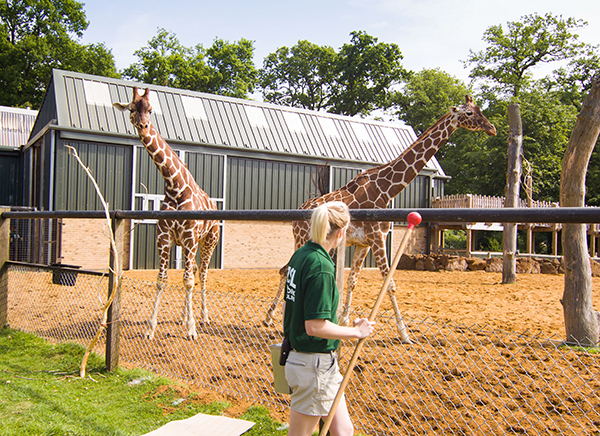Do long limbs really provide a leg up?

Musculoskeletal models reveal the impact of giraffe’s long limbs on its mobility.
New research from the RVC has revealed new insights into giraffe mobility and how the efficiency of movements in relation to body mass appears to plateau amongst animals of a certain size. These findings contradict what is commonly assumed for many mammals – that possessing long, straight limbs necessarily confers a mechanical advantage which enhances speed and muscle efficiency.
The study, which was published today in Proceedings of the National Academy of Sciences (PNAS), was conducted by creating 3D musculoskeletal models of the forelimbs of giraffes and two related species, the living okapi (Okapia johnstoni), known as the “forest giraffe” found in Central Africa, and the extinct Sivatherium giganteum, one of the largest known giraffes, from the Himalayan foothills more than two million years ago. The researchers then used motion capture and force data to measure muscle efficiency for walking giraffes while estimating the efficiency of the other two species.

Together, the researchers, led by Professor John Hutchinson, Professor of Evolutionary Biomechanics at the RVC, and former RVC PhD student Dr Christopher Basu, now a Lecturer in Veterinary Anatomy at the University of Surrey, found that the assumed advantages for increasing mass and limb length in mammals do not apply to giraffes. This is because the length of giraffes’ limbs is extreme, and while this aids feeding from trees, it may not increase athleticism.
Instead, the study found that giraffes’ effective mechanical advantage, a measure of limb efficiency in producing muscle forces, was four times less than would have been expected based on data extrapolated from a range of similar animals. This indicates giraffes’ muscles have to generate relatively high forces to conduct behaviours that a smaller animal, even a horse, can do more effectively.
Comparing the three species tested, the researchers also determined that the effective mechanical advantaged varied. For example, while the giraffe and Sivatherium giganteum have similar body mass, the giraffe had lower effective mechanical advantage. Meanwhile, the giraffe and okapi had similar effective mechanical advantage, despite the giraffe has four to six times the body mass of an okapi. This suggests that past a certain size, approximately that of a horse, the increase in effective mechanical advantage associated with a greater body mass plateaus or even decreases.

From these findings, it was further concluded that taller animals are only likely to have greater effective mechanical advantage if the distance between the muscle and the pivot point of the joint is proportional to their limb length.
Professor John Hutchinson, Professor of Evolutionary Biomechanics at the RVC, said:
“This study represents a powerful fusion of experimental data with modern computer modelling methods, together giving rather surprising insights into not only how living giraffe limbs work in locomotion, but also into the diversity of limb functions across different body sizes in giraffe species through evolutionary time. That’s a cool result.”
Dr Christopher Basu, Lecturer in Veterinary Anatomy at the University of Surrey, said:
“Giraffes are instantly recognisable and an unforgettable sight in the wild and in zoos across the world. But we know surprisingly little about them and their close relatives, particularly when it comes to their anatomy and biomechanics. Our study shows how giraffes’ anatomy impacts the way their limbs function, and teaches us something new about their evolutionary story.”
The research was funded by the Natural Environment Research Council (UK).

Notes to Editors
You can view the full paper online at: https://www.pnas.org/doi/10.1073/pnas.2108471119
For more information please contact:
- Jasmin De Vivo jasmin.devivo@plmr.co.uk or rvc@plmr.co.uk
- Press Line: 0800 368 9520
About the RVC
- The Royal Veterinary College (RVC) is the UK's largest and longest established independent veterinary school and is a Member Institution of the University of London.
- It is one of the few veterinary schools in the world that hold accreditations from the RCVS in the UK (with reciprocal recognition from the AVBC for Australasia, the VCI for Ireland and the SAVC for South Africa), the EAEVE in the EU, and the AVMA in the USA and Canada.
- The RVC is ranked as the top veterinary school in the world in line QS World University Rankings by subject, 2022.
- he RVC offers undergraduate and postgraduate programmes in veterinary medicine, veterinary nursing and biological sciences.
- A research led institution with 88% of its research rated as internationally excellent or world class in the Research Excellence Framework 2021.
- The RVC provides animal owners and the veterinary profession with access to expert veterinary care and advice through its teaching hospitals and first opinion practices in London and Hertfordshire.

